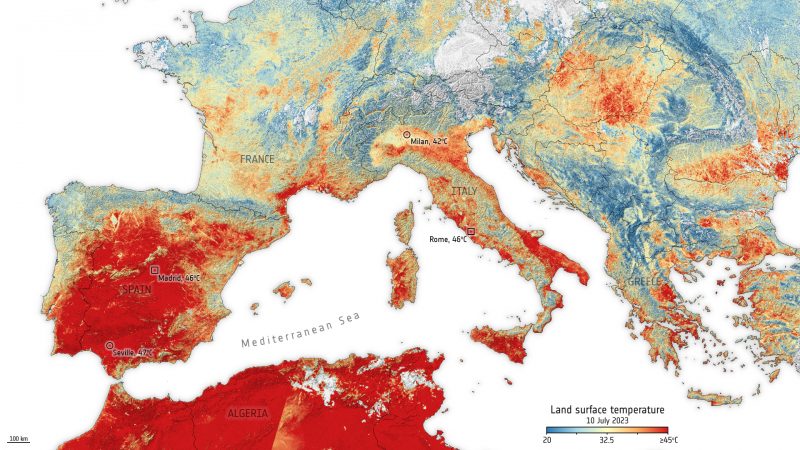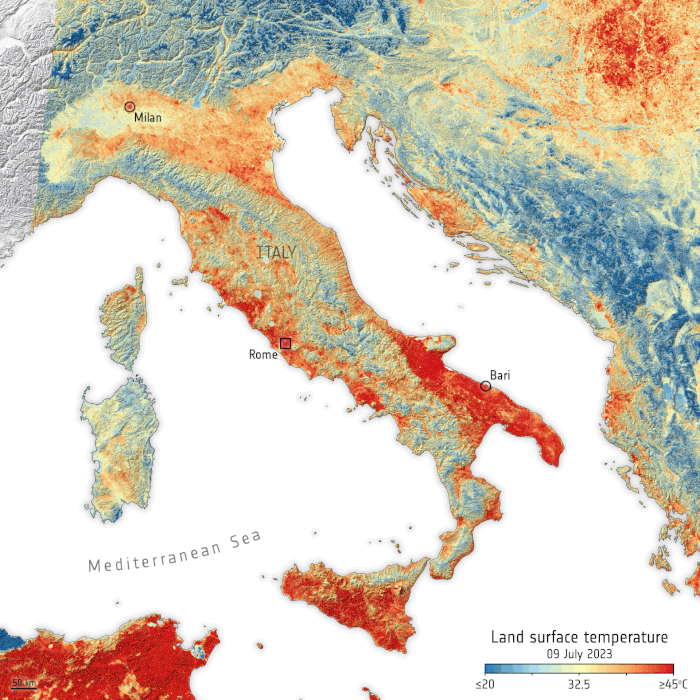
European heatwave and record temperatures
Summer is turning up the heat in Europe. An anticyclone – a high-pressure region that allows heat to build – will settle over Italy this week and could bring some of the hottest temperatures ever recorded in Europe. Meteorologists have named the anticyclone Cerberus, one of the hounds of the god Hades and a character in Dante’s Inferno.
The current record holder for highest temperature in European history is 48.8 degrees Celsius (119.84 F). That record was set almost two years ago, August 11, 2021, in Floridia, Sicily. The world’s highest recorded temperature ever was 56.7 C (134.1 F) in Death Valley, California, in 1913. The southern U.S. is also currently under a heatwave, with temperatures at Death Valley expected to climb above 120 F.
Satellite records land surface temps
ESA’s Copernicus Sentinel-3 satellite has been taking Earth’s temperature from above. The satellite records land surface temperatures, which are hotter than air temperatures that you see in forecasts. Land surface temperatures measure the real amount of energy radiating from Earth. On July 9 and 10, 2023, some of the land surface temperatures exceeded 45 C (113 F), and Sicily had land temperatures over 50 C (122 F). (See gif below.) Plus, the satellite took these temperatures just before noon. The temperatures were likely hotter later in the day.
Land surface temperatures are useful to scientists in a number of ways. First, they’re useful for understanding and forecasting weather and climate patterns. Second, these readings are helpful in monitoring fires. Third, they’re an important gauge for the best use of irrigation on farm crops. And fourth, they aid in planning for mitigating heat in urban areas.

A record-setting summer
Accurate land surface temperatures are helpful in this already record-setting summer. June 2023 was the hottest June on record, and the hottest week on record came in early July. In addition, Antarctic sea ice is at record lows.
Benjamin Koetz, a mission scientist for ESA, said:
Climate warming amplified this year by El Niño severely affects food production, water availability, as well as our health. To properly adapt to these changes, we need timely information at actionable resolution. The Copernicus program is providing this with Sentinel-3 and soon with the Copernicus Land Surface Temperature Monitoring mission at 50-meter resolution.
Extreme heat is the number one weather-related killer. The peer-reviewed journal Nature Medicine published a study on July 10, 2023, showing that more than 60,000 people died in 2022 in a heatwave in Europe. Italy, Greece, Spain and Portugal saw the most deaths. So far, this summer is forecast to be worse. Learn more about how to protect yourself in extreme heat.
Bottom line: ESA’s Sentinel-3 satellite is keeping an eye on the European heatwave, recording land surface temperatures that aid forecasts and urban planning.
The post European heatwave bakes areas around the Mediterranean first appeared on EarthSky.
from EarthSky https://ift.tt/jGzXkJ0

European heatwave and record temperatures
Summer is turning up the heat in Europe. An anticyclone – a high-pressure region that allows heat to build – will settle over Italy this week and could bring some of the hottest temperatures ever recorded in Europe. Meteorologists have named the anticyclone Cerberus, one of the hounds of the god Hades and a character in Dante’s Inferno.
The current record holder for highest temperature in European history is 48.8 degrees Celsius (119.84 F). That record was set almost two years ago, August 11, 2021, in Floridia, Sicily. The world’s highest recorded temperature ever was 56.7 C (134.1 F) in Death Valley, California, in 1913. The southern U.S. is also currently under a heatwave, with temperatures at Death Valley expected to climb above 120 F.
Satellite records land surface temps
ESA’s Copernicus Sentinel-3 satellite has been taking Earth’s temperature from above. The satellite records land surface temperatures, which are hotter than air temperatures that you see in forecasts. Land surface temperatures measure the real amount of energy radiating from Earth. On July 9 and 10, 2023, some of the land surface temperatures exceeded 45 C (113 F), and Sicily had land temperatures over 50 C (122 F). (See gif below.) Plus, the satellite took these temperatures just before noon. The temperatures were likely hotter later in the day.
Land surface temperatures are useful to scientists in a number of ways. First, they’re useful for understanding and forecasting weather and climate patterns. Second, these readings are helpful in monitoring fires. Third, they’re an important gauge for the best use of irrigation on farm crops. And fourth, they aid in planning for mitigating heat in urban areas.

A record-setting summer
Accurate land surface temperatures are helpful in this already record-setting summer. June 2023 was the hottest June on record, and the hottest week on record came in early July. In addition, Antarctic sea ice is at record lows.
Benjamin Koetz, a mission scientist for ESA, said:
Climate warming amplified this year by El Niño severely affects food production, water availability, as well as our health. To properly adapt to these changes, we need timely information at actionable resolution. The Copernicus program is providing this with Sentinel-3 and soon with the Copernicus Land Surface Temperature Monitoring mission at 50-meter resolution.
Extreme heat is the number one weather-related killer. The peer-reviewed journal Nature Medicine published a study on July 10, 2023, showing that more than 60,000 people died in 2022 in a heatwave in Europe. Italy, Greece, Spain and Portugal saw the most deaths. So far, this summer is forecast to be worse. Learn more about how to protect yourself in extreme heat.
Bottom line: ESA’s Sentinel-3 satellite is keeping an eye on the European heatwave, recording land surface temperatures that aid forecasts and urban planning.
The post European heatwave bakes areas around the Mediterranean first appeared on EarthSky.
from EarthSky https://ift.tt/jGzXkJ0

Aucun commentaire:
Enregistrer un commentaire